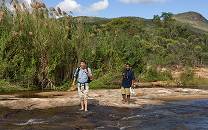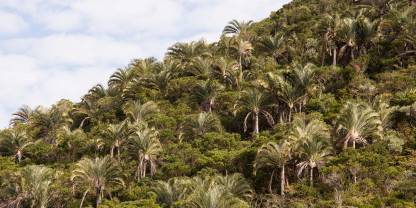Andohahela National Park (Parc National d’Andohahela) protects the last remaining 1,000-or-so wild specimens of the rare triangle palm. A Unesco World Heritage Site since 2007, the park comprises three different sectors that collectively include a remarkable range of habitats. The most regularly visited sector only covers 5km²/2mi², but it is easily accessed from a main road and is home to ring-tailed lemur and Verreaux’s sifaka.

-
Best Time To Go
- April, May, September, October and November (Less rain, active wildlife)
-
High Season
- July, August and December holidays (More day visitors)
-
Size
- 727km² / 281mi²
-
Altitude
-
78-1,907m /256-6,257ft
 View Photos
View Photos
 View Photos
+8
Photos
View Photos
+8
Photos
Pros & Cons
- Very accessible: it’s next to a main road in the far south
- Scenic park with interesting flora such as the rare triangle palm
- Ring-tailed lemur and Verreaux’s sifaka are often seen
- Only basic camping space available
- Large park but very small accessible area
Wildlife
The charismatic ring-tailed lemur and the dancing Verreaux’s sifaka are the most frequently seen of 10 lemur species recorded in Andohahela. The white-footed sportive lemur, which is active at night, can sometimes be found resting in the fork of a tree during the daytime. Other animals to look out for include the lesser hedgehog tenrec and the radiated tortoise.
More about Andohahela’s wildlifeScenery
Andohahela is a hilly park that consists of three disconnected areas, each with different scenery and vegetation. Of the two larger sectors, one protects a rainforest habitat and the other a cover of drier . The smallest but most accessible sector is a beautiful 5km²/2mi² stand of on the Ambolo Mountains. This last sector is the only place in Madagascar where the rare triangle palm grows.
Activities
There are three different guided trails in Andohahela. Most popular is the 3.7km/2.3mi Circuit de Tsimelahy, which starts at the village for which it is named. You will see plenty of along this trail, as well as an impressive old . Less certain but also likely to be seen are lemurs such as Verreaux’s sifaka and ring-tailed lemur.
Weather & Climate
Andohahela consists of three different sections with different climates. The area most visited, between the and rainforest, is the transition area, which is warm to hot with average rainfall. April to October is the Dry season and November to March sees the most rainfall. The Dry season months have average daytime temperatures of 23°C/73°F.
More about the weather and climateBest Time To Visit
Most people visit Andohahela to hike and enjoy the scenery of the . The Dry season months of April to October offer the best hiking conditions. If you would like to increase the chances of seeing some wildlife, the shoulder months of April, May, September, October and November are the best times overall. From June to August, reptiles, amphibians and some nocturnal lemurs are less active and might be harder to spot.
More about the best time to visit
